Can a Broken Urban Park Be Fixed? Portland’s O’Bryant Square: Part 3
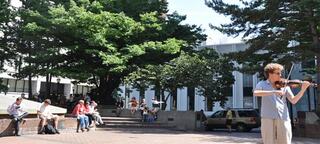
This is the third and final(?) installment in our series on the design, function, and future of Portland’s O’Bryant Square. To catch up on the conversation, be sure to read through the first two segments:
Part 1 – An overview of the park’s history and some of its key challenges
Moving beyond the tangible aspects of a park, it is crucial to consider how people actually use the space, as well as how they might be guided to use it. The “programming” of a park can be created by the entity that owns/manages the space; alternatively, different types of programming can evolve organically from the interplay of activities happening in and around the park.
Widely regarded as Portland’s “living room,” Pioneer Courthouse Square stands as the local model of intentional municipal programming. Originally opened in 1984 displacing a post-WWII parking lot, Pioneer Square hosts the flagship downtown events and civic celebrations including annual events such as Sand in the City and the Christmas tree-lighting (which unfortunately made headlines last year). But does the programming approach at Pioneer, based on its scale and intent, bear any lessons for the less visible O’Bryant Square?
How about Director Park, which we discussed in Part 2? Our own Eric Ridenour, who for several years lived a 3-minute’s walk from Director, also speaks of how the park functioned as an outdoor extension of his living space through the warm summer months. That said, he perceived more of a “community” nuance taking place at Director in comparison to Pioneer. From private wedding ceremonies to studios for the Oregon Ballet Theatre to the giant-sized garden chess board, the programming range draws a large swath of downtown residents and visitors alike. Rather than employing a primary “destination” strategy (à la “program it and they will come”), Director uses community-focused events as well as its physical design (the chess board and its popular fountain) to draw “customers” from its immediate surroundings – the MAX light rail train, many attractive retail shops, hotels, and multiple restaurants.
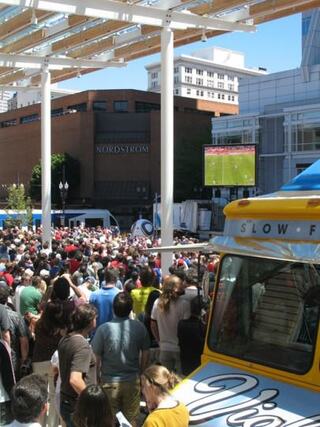
World Cup at Director Park
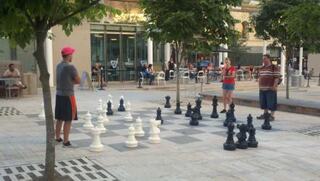
Garden Chess at Director Park
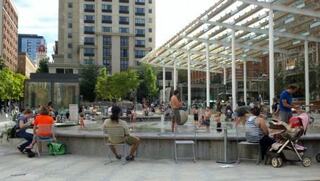
Splash Pad at Director Park
O’Bryant Square lacks these intentional approaches to programming, likely due to the lack of rich interaction available in its immediate surroundings (which we highlighted in Part 1) – that is, until the food cart phenomenon exploded here in Portland.
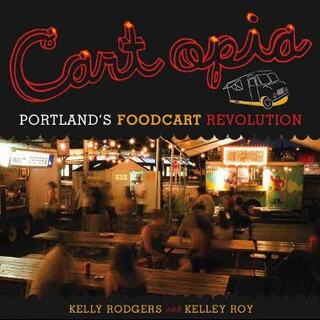
For a window into Portland's "food cart revolution," we recommend the book Cartopia by Rodgers & Roy.
The food cart scene has given O’Bryant a serendipitous shot-in-the-arm as one of the city’s largest cart clusters (or “pods”) has taken root on an adjacent city block during the past couple of the years. What began as a small pod of carts has turned into a destination spot with carts lining all four sides of the block as well as a stretch along another block. The resulting activity has been staggering. Brett Burmeister, creator of the online clearinghouse of all-things-food-carts, FoodCartsPortland.com, recently wrote an insightful piece on this so-called “Rebirth of O’Bryant Square”…
This past week, on a sunny day, I picked up lunch from 808 Grinds on the corner of SW 9th and Washington – a cart that is part of the expansion of the Alder pod in 2010 and 2011. I crossed the street to O’Bryant Square and was shocked at how difficult it was to find a place to sit down and enjoy lunch. While eating, I marveled in the activity in the square. Children were running about being pursued by their happy parents. A fiddler in the center of the square entertained everyone. There were people everywhere, eating or chatting or just relaxing. I overheard a woman comment, “this is strange, I would never have come to Crack Park just a few years ago.” It made me realize that this park has seen a rebirth and has been rediscovered by a new group of patrons who enjoy it during the day with their lunches from the carts.
Did Crack Park once again become O’Bryant Square as a result of the food carts? I don’t know, but I refuse to believe that the increased foot traffic in the area and 20 new micro-restaurants that have arrived in the last six months don’t have something to do with it. The city has even replaced the wood benches this summer realizing that the park is being used more and more each day. Next, I hope they plant some roses or just some colorful shrubs to liven it up a bit.
It was interesting to read Burmeister’s thoughts on how the food carts have revitalized O’Bryant because it was that same observation that sparked this blog series a few months back. We watched the activity at O’Bryant as the warm, dry summer has given way to cooler autumn temperatures, and it has been fascinating to note how the use of the park’s hardscape evolves with the conditions. The numerous brick steps and retaining walls transform into stadium seating; as the temperatures drop, the crowd tracks the sunny spots; and even on misty days, a decent gathering of food cart diners take their lunch break within O’Bryant.
With a nod to the public space observation films from the 1980s by William Whyte, the following video offers a glimpse of the activity produced by the food carts…
So where does all of this lead? The food carts by their very nature are mobile and temporary, even though the movement seems to have significant staying power at the moment. And yet, in any case, are the food carts enough redemption for O’Bryant Square? There certainly appears to be a strong symbiotic relationship between the park and the carts that should, if anything, be strengthened. Building on the comments made on Part 2 of this series by Katrina from ThinkUrban.org, the relatively low-cost additions of movable chairs & tables could enhance the already vibrant lunch scene. (And why not? They’ve worked so famously for New York’s aptly-named Bryant Park.)
But what about the bigger picture? Outside of the lunch hour, O’Bryant hasn’t quite shaken the “Crack Park” reputation. Does O’Bryant have the potential to become a destination downtown park, or will it always be a lower-tier space in the city fabric?
On a directly related note, the folks over at Planetizen have just finished a crowdsourcing project with the Project for Public Spaces to get a sense of the public’s view of the Top 100 Public Spaces in the U.S. and Canada. The result is a fabulous collection of parks that each offer lessons in design and programming. Portland took four spots in the top 100: Director Park (#15), Keller Fountain Park (#20), Pioneer Courthouse Square (#39), and Jamison Square (#92).

